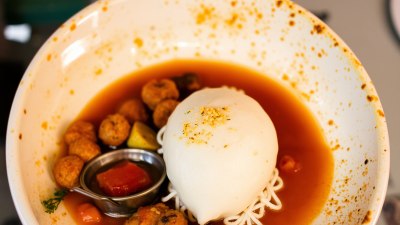In-Flight Dining 101: How to Eat Gracefully Without Making a Mess
Tips for eating gracefully on a plane without the stress of making a mess during in-flight dining.

Image created with Flux Schnell
Eating while flying can be challenging, especially if you want to maintain a semblance of grace and etiquette. In-flight dining is not just about satisfying hunger; it's also about navigating a confined space with fellow passengers in close proximity. This article delves into various strategies and tips to enhance your in-flight dining experience, focusing on how to eat gracefully without the mess.
Choose the Right Meal
One of the first steps towards a smooth in-flight dining experience begins long before your flight. Selecting the right meal can significantly reduce the chances of making a mess. For instance, meals that are served in a bowl or a sturdy container typically minimize spills. Opt for items like pasta, stews, or certain types of sandwiches rather than salads or dishes with loose ingredients that might spill. Additionally, pre-packaged meals or those that come with separate compartments can help in containing the food better.Stay Hydrated Prior to the Flight
Before your flight, it’s important to stay hydrated but avoid excessive consumption of fluids right before boarding. This will not only help in avoiding any urgent trips to the restroom during your meal but will also make you feel lighter and more comfortable. Dehydration can lead to dry mouth and discomfort when eating, making the whole process clumsier and messier.Master the Art of Using Utensils
Proper use of utensils is crucial for in-flight dining. In confined spaces, the way you handle your fork and knife can make a big difference. Hold the utensils comfortably and use small, deliberate movements. Try to cut food into smaller pieces before taking a bite. This makes it easier to control the food and minimizes the chance of anything falling off. If your meal comes with a spoon, check if it’s easier to manage the meal with just a fork. Sometimes, one utensil is sufficient for the task.Table Space Awareness
Airplane trays are not expansive. It’s essential to be mindful of your surroundings and the space you have. Before the meal is served, clear your tray of any non-essential items like magazines or personal belongings to maximize your working area. If there’s an option, request that your meal be served on a separate tray rather than directly on the fold-out tray. This can help avoid spills and provide a little extra room for maneuvering.Use Napkins Generously
Napkins can save the day in many dining scenarios, especially in-flight meals. Use the napkin before you start eating, placing it on your lap to catch any potential crumbs or spills. If you do spill something, don’t panic. Use the napkin to blot the area gently; it’s important not to rub, as this can make stains worse. Having extra napkins on hand from your meal can also be helpful for those little spills that can happen here and there.Mind Your Portions
A common mistake people make when dining on a plane is not paying attention to portion sizes. Large bites or overfilling your fork can lead to accidents and spills. Instead, take smaller bites and avoid loading your utensils with too much food at once. This not only reduces potential mess but allows you to savor the meal more slowly. Eating at a leisurely pace makes for a more enjoyable experience and helps you stay relaxed.Be Attentive When Drinking
Drinks are often part of in-flight dining, and care needs to be taken when enjoying beverages. Always use the lid on drinks if available, especially for hot beverages, to prevent drips. When drinking, tilt the cup or glass slightly away from your body to catch any spills. Hold it delicately but securely, ensuring a firm grip without causing unnecessary pressure. If you’re offered a beverage that’s difficult to manage in-flight, such as a large soda can, consider asking for it to be poured into a cup instead.Engage in Quiet Conversation
If you are traveling with companions, engaging in light conversation during the meal can make the experience more pleasant. However, be mindful of your mouthfuls; it’s best to avoid talking when your mouth is full. This is not only more courteous, but it helps prevent accidental spills of food and drink. Instead, take bites, chew, and then participate in the conversation. Good timing and pacing can prevent awkward situations.Respect Personal Space
While dining on a flight, respect the personal space of your neighbors. Avoid leaning over or reaching too far when passing items or trying to grab something. If you need something from the aisle, like a drink or snack, let the flight attendants help you rather than risking discomfort with other passengers. Always be conscientious about how your dining habits may affect those sitting near you.Adjust Your Eating Rhythm to Flight Movement
Understand that the movement of the aircraft can impact your eating rhythm, especially during turbulence. If the seatbelt sign is on, it's best to avoid eating entirely. Wait for stable conditions to enjoy your meal. When navigating turbulence, adjust how quickly you eat and be prepared for any sudden jolts that may necessitate putting your food down momentarily.Handle Trash Responsibly
After you’ve finished your meal, it’s essential to handle any trash responsibly. Make sure you don’t leave behind any wrappers, utensils, or containers that can be troublesome for cabin crew. If you have bags or additional trash, keep it neatly tucked away until the meal service is complete, and you can properly dispose of it. Being considerate of the shared space contributes to a better atmosphere for all passengers.Practice Makes Perfect
Dining gracefully in-flight is a skill that gets better with practice. The more you fly and take meals in-flight, the better you’ll become at managing your dining experience. Each flight can be an opportunity to refine your techniques for handling food in this unique environment. Learn from your experiences—what worked, what didn’t—and adapt your approach accordingly.Final Thoughts
While eating in-flight may seem daunting, following these strategies can make the experience much smoother and more enjoyable. From choosing the right meal to being mindful of the available space and adhering to proper etiquette, each aspect contributes to a graceful dining experience. Remember, the key lies in preparation, awareness, and consideration—not only for your own comfort but also for the passengers sharing the journey with you. Keep Exploring











